This is the second in a short learning strategy series on how to run your learning initiatives for success. In the first, we talked about taking the time upfront to clarify the reasons for your project, so now let’s turn our attention to your learners.
Let’s say you’ve been working on the design of a learning programme. You’ve aligned its objectives with your organisation’s goals, and now you want to make sure your learning design is a hit with your learners. So let’s focus on them.
They’re busy people. They have their tasks and responsibilities, and in many cases, they are already involved in some form of training. So, starting with your programme launch, and working backwards here are five things you can do to help your learners engage, complete, and benefit from the learning that you offer.
Make it easy to find
Netflix makes it easy for viewers to find and consume content. They have an algorithm that serves up content that they think you’ll watch. It’s not always great: sometimes we watch it because it’s there, and it’s easy, and we don’t have to exert ourselves mentally (especially after a hard day at the office!). We’re not suggesting you take exactly this approach with your learning, but careful curation, tagging, and clear learner journeys, on whatever platform being used, can really help drive engagement with your learning programmes.
Help your learners prioritise
This points to having a clear purpose for your programme, and a clear statement of why it matters to the organisation and the individual. Get this right and your learning will suddenly appear more attractive to your learners.
You can go further. Consider the well-known prioritisation tool, the Eisenhower framework, which categorises tasks in terms of importance and urgency. How important, and how urgent is your programme for your intended learners? And how does this compare to the importance and urgency of other learning programmes? For example, a compliance course on financial instruments might be important and urgent, for an organisation that needs to maintain external accreditation.
Armed with this information, you can send appropriate messages, ranging from “Do it now!” through to “Schedule some time for this in the next week”. And you can also vary your message depending on your audience. A programme might be important and urgent for some roles, but less so for others.
Design for your learners’ context
One example of context comes from Paul Graham. He’s the co-founder of Y Combinator, a startup incubator and writes well-considered essays on a range of topics. In “Maker's Schedule, Manager's Schedule”, he talks about a key contextual difference between managers, and makers (ie, people who produce work artefacts, such as writers, software developers, graphic designers, and so on). Managers’ time tends to be broken down into 60-minute, or 30-minute slots, with managers jumping from one thing to another. On any given day, their focus is split across different tasks, problems, projects, and issues. “Makers” on the other hand work with larger tasks requiring longer focus time.
Managers may already be suffering from a form of cognitive overload due to the variety and fragmentation in their work. This can lead to a superficial approach, when there is no time to dig into an issue or problem. If these are your intended learners, you might time your programme for when there are fewer competing demands. Or you could make a conscious decision to schedule longer blocks of time to take them away from their day to day context, so that they have no distractions and can focus more deeply.
For makers, there’s a different consideration. When people are focused deeply on a task, research shows that interruptions can be very costly. Psychologists talk about “switching costs” – ie the hit in terms of efficiency and effectiveness that comes from switching from one task to another. And for “makers”, this cost is high! One consideration for you here is when you schedule any learning events, or whether a self-serve or asynchronous model where learners can schedule their own blocks of learning time would be better.
Know your learners
It’s not generally as easy as categorising your learners as makers or managers. People are more complex than that, and groups of learners will be much more diverse, so in addition to their context, you’ll need to understand and empathise with your learners. If you have a clear view of their pain points, the barriers and challenges they face and their aims and goals, you can make design choices that will support them better.
One way to do this is to develop some personas of your learners. Personas represent your target audience, and they help guide you in making design decisions. They include names, background, skills and attitudes, and other details. If you rely on actual data to guide you, these can be very helpful in making sure you consider the diversity of your audience. Of course, if you really want to design for your learners, the obvious step is to involve them in the design...
Involve your learners
A truly learner-centric approach is to involve your learners in the design, and co-create the learning solution with them. This would let you really understand them, and develop something that they’ll find relevant, while also empowering them, increasing their buy-in and commitment to learning from the very beginning. This can be as simple as focus groups, or a series of workshop sessions, or it can be more involved where they act as subject matter experts, input into programme design, review content and act as full partners in the process.
Conclusion
It’s not enough to have a programme that aligns with your business needs: you also need to think deeply about your learners – who they are, what kind of schedule they’re on, the pressures and challenges that they face. Bring them into your design process as much as possible, and as early as possible. The result will be a better experience for you and for them, with higher engagement rates, and greater impact to drive your business performance.
Interested in a learning strategy that works? Talk to us today.







Was this article helpful?